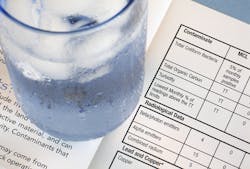Q: What are VOCs, and why are they frequently regulated?
A: VOCs are volatile organic chemicals, which means they have relatively high vapor pressures under normal conditions and therefore tend to evaporate.
What is a VOC? You’ll know one when you see it, or a regulatory agency will tell you. Canada and the European Union define VOCs as organic compounds with boiling points less than 250oC (482oF) at atmospheric pressure. In the U.S., VOCs are broadly defined with many classified for regulatory purposes, while others are excluded because they do not significantly contribute to atmospheric ozone formation.
VOCs are organic chemicals categorized by their capability to evaporate under mild conditions. They are usually small molecules, and because they are nonpolar, their boiling points tend to be relatively low and their vapor pressures high under ambient conditions, causing them to eventually escape into the air. Many are solvents and used in paints and other important and high volume commercial applications. Gasoline is a mixture of VOCs, as is vodka and ethyl alcohol with about 50 percent water.
Some people mistakenly think the term VOC indicates that it is explosive or harmful, but it is simply a technical term describing a physical property of a chemical. Thousands of natural and synthetic chemicals are VOCs. Volatility is not necessarily a bad thing, but it can increase human exposure potential to a chemical by inhalation. If the chemical is also toxic, it can be a health concern. The principle environmental aspects of VOCs are the ability of some to be released into outdoor air and contribute to smog due to photochemical formation of ozone in the lower atmosphere or ozone reduction in the upper atmosphere and the presence of some in drinking water from external contamination and as disinfection byproducts (DBPs).
Examples of VOCs
Both natural and synthetic VOCs are produced in multibillions of pounds per year. As just one example, pine forests produce many different volatile compounds based on the isoprene chemical structure. Isoprene (C5H8) is a small simple molecule with two double bonds, so it is volatile and very biologically and photochemically active. The double bonds have weakly bound electrons, so they are very reactive with ultraviolet light as well as susceptible to other chemical processes.
Isoprene polymerizes and reacts in many combinations to form terpenes, terpene derivatives and other important biologically active chemicals (also VOCs) that are essential for plant function. Isoprene is even the chemical building block for many pheromones or exo hormones for insects that are indigenous in forests. Its photochemical reactivity helps make the Great Smoky Mountains "smokey." Numerous natural alcohols and esters like amyl acetate and other taste chemicals owe their aromatic sensations to being volatile as well.
Indoor air is usually a much greater source of synthetic VOC exposure than outdoor air. Indoor air receives VOC contributions from paint, carpets, adhesives, coatings, furniture, plasticizers, smoking, fire places, cleaners, laundry and showering.
Many types of industrial chemicals are VOCs. An important feature of the functionality of solvents such as benzene and halogenated chemicals such as tetrachloroethylene is their ease of evaporation or distillation at near ambient or slightly higher temperatures, which is why many of them are regulated. Solvents and additives in paints will spontaneously evaporate as the paint cures. Others are used as cleaners and degreasers and readily separated from the residues by low temperature and low energy cost distillation. Solvent-free and electrostatic applications are used in many industries to avoid the use of VOCs and not exceed release limitations on volatile chemicals. Shields on gasoline pump nozzles, carbon canisters and sealed gas caps are intended to suppress gasoline VOC emissions.
Freons and other similar chlorofluorocarbon refrigerants have been regulated because they are stable VOCs that can reach the upper atmosphere when released. Their photochemical stability prevents their decomposition in the lower atmosphere, so they survive until they reach the upper atmosphere/stratosphere where they encounter higher energy ultraviolet (UV). The free radicals can react to deplete upper level ozone, which shields us from the transport of higher energy photons and allows more dangerous UV to reach the Earth’s surface.
Drinking water
VOCs in drinking water come from two predominant sources. Industrial contaminants from releases, air deposition and waste disposal are principally groundwater contaminants because they are not able to evaporate from the subsurface. The second, byproducts from chemical disinfection, are more likely surface water issues because usually more natural total organic carbon is present in surface waters to react with the disinfectant during water treatment.
Industrial VOCs in surface water are more likely to evaporate from the surface to the atmosphere, but many groundwater contaminants can be biologically decomposed by bacteria. For example, trichloroethylene will ultimately be degraded to dichloroethylene, vinyl chloride and finally chloride, under the appropriate anerobic conditions of concentrations; nutrients; and electron donor sources such as nitrate, bacteria and time.
Disinfection byproducts
The greatest numbers of DBPs in drinking water are generated from reactions of chemical disinfectants with organic carbon that is naturally present in the water. Oxidation and halogenation can occur, and probably more than 1,000 individual VOCs have been cumulatively identified in the numerous analytical studies that have been conducted. Their individual concentrations are usually in parts per billion and parts per trillion or less. The total concentration in a water sample is typically considerably less than 1 part per million, depending on source water, treatment technology and water chemistry.
The dominant groups of DBPs have been identified as trihalomethanes (THMs) that include chloroform, bromodichloromethane, dibromochlorimethane and bromoform and are currently regulated at 80 micrograms per liter (µg/l.), and haloacetic acids (HAA5) that include chloroacetic, bromoacetic, dibromoacetic, dichloroacetic and trichloroacetic acids and are currently regulated at 60 µg/l.
THMs were regulated in 1979 as chemicals that were dominant and indicator surrogates for the presence of many other DBPs that were not identified. They were also considered to be potential carcinogens based on animal test information with greater or lesser amounts of toxicology data. With improvements in animal testing, the U.S. Environmental Protection Agency (EPA) no longer considers chloroform a non-threshold carcinogen in drinking water, and later testing of the other 3 THMs yielded negative results. HAA5 have more biological activity than THMs.
Other drinking water regulations
In 1987, the EPA produced maximum contaminant levels (MCLs) for eight VOCs that were being detected in groundwaters: trichloroethylene, carbon tetrachloride, vinyl chloride, 1,2-dichloroethane, benzene, para-dichlorobenzene, 1,1,-dichloroethylene and 1,1,1-trichloroethane. The first five were regulated as probable or human carcinogens, two were possible carcinogens and one was not considered to be a carcinogen. Each of these had undergone a risk assessment, and numerical values were calculated as "safe" MCLs. All of these are detectable by the same analytical method and treatable by aeration or with granular activated carbon.
In February 2011, the EPA announced its intent to propose a group regulation for carcinogenic VOCs. It would incorporate five chemicals from the original 1987 regulation and up to 11 more, including 1,2,3-trichloropropane. The group concept is not new, as numerous other drinking water regulations were as groups (such as THMs, HAA5, coliform bacteria and radionuclides) based on common analytical and treatment technologies. However, regulating individual carcinogens as a group based on their toxicology has serious logical and quantitative risk assessment difficulties, such as the need to understand the Modes of Action (MOE) of each chemical. If that were known, then it might be scientifically credible to prorate and group those that have the same MOE, but the MOEs are often not known.
Five years have passed since the original EPA announcement, but a proposed rule has not yet appeared. In addition, since eight synthetic VOCs had been regulated, and it is fairly common that if one is present, others could also be in a water supply, and treatment would remove all of them. Apart from the need for a plausible regulatory logic, questions may arise as to whether a group regulation for carcinogenic VOCs would have any significant public health or cost benefits over one or two additional MCLs for VOCs with sufficient occurrence.
Exposure in water
Ingestion of water containing a chemical would be the usual most important source of exposure. However, because of the volatility, VOC inhalation during showering and bathing could be a source. Some studies have indicated that contributions from showering and bathing could be approximately equivalent to ingestion. In addition, dermal exposures could be a contributor to total daily dose, especially from swimming in chlorinated pools where ingestion would be small but inhalation and dermal exposure would be greater.
Chemical analyses
EPA method 524.2 Purge and Trap Gas Chromatography/Mass Spectrometry is a designated method for VOC analyses in drinking water. It is capable of identifying at least 75 halogenated and aromatic chemical VOCs in one sweep with detections at usually less than 0.3 µg/liter with about 13 minutes of gas chromatography cycle time per sample. Other similar chemicals can be included with appropriate calibrations. Airborne sampling requires more complex collection procedures.
Conclusions
VOCs make up a large number of natural and synthetic chemicals, with commonality in their propensity to evaporate because of their low boiling points and high vapor pressures. Some VOC releases are regulated because they contribute to lower atmosphere ozone production, and others can contribute to upper atmosphere ozone depletion.
Drinking water VOCs can occur from external contamination from waste disposal, especially groundwater, and from DBP formation, especially in surface waters. Indoor air is a greater exposure source to synthetic VOCs than outdoor air. Numerous VOCs in drinking water have been directly or indirectly regulated. Many VOCs are readily analyzed by a single procedure, and they can be removed from water by either aeration or with granular activated carbon.
Dr. Joe Cotruvo is president of Joseph Cotruvo and Associates, LLC, Water, Environment and Public Health Consultants. He is a former director of the EPA Drinking Water Standards Division.


